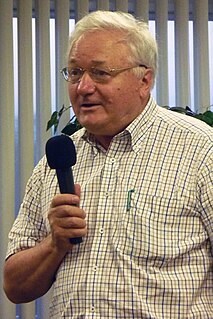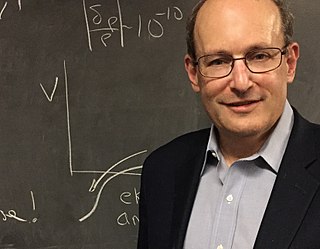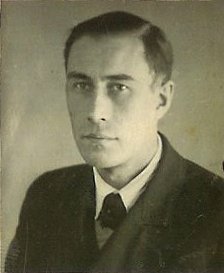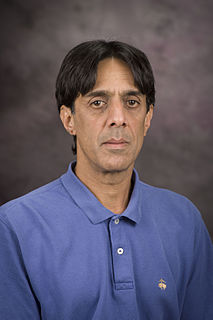
In physical cosmology, cosmic inflation, cosmological inflation, or just inflation, is a theory of exponential expansion of space in the early universe. The inflationary epoch lasted from 10−36 seconds after the conjectured Big Bang singularity to some time between 10−33 and 10−32 seconds after the singularity. Following the inflationary period, the universe continues to expand, but at a less rapid rate.

The cosmic microwave background is electromagnetic radiation as a remnant from an early stage of the universe in Big Bang cosmology. In older literature, the CMB is also variously known as cosmic microwave background radiation (CMBR) or "relic radiation". The CMB is a faint cosmic background radiation filling all space that is an important source of data on the early universe because it is the oldest electromagnetic radiation in the universe, dating to the epoch of recombination. With a traditional optical telescope, the space between stars and galaxies is completely dark. However, a sufficiently sensitive radio telescope shows a faint background noise, or glow, almost isotropic, that is not associated with any star, galaxy, or other object. This glow is strongest in the microwave region of the radio spectrum. The accidental discovery of the CMB in 1964 by American radio astronomers Arno Penzias and Robert Wilson was the culmination of work initiated in the 1940s, and earned the discoverers the 1978 Nobel Prize in Physics.

Rashid Alievich Sunyaev is a Soviet and Russian astrophysicist of Tatar descent. He was educated at the Moscow Institute of Physics and Technology (MS). He became a professor at MIPT in 1974. Sunyaev was the head of the High Energy Astrophysics Department of the Russian Academy of Sciences, and has been chief scientist of the Academy's Space Research Institute since 1992. He has also been a director of the Max Planck Institute for Astrophysics in Garching, Germany since 1996.

Andrei Dmitriyevich Linde is a Russian-American theoretical physicist and the Harald Trap Friis Professor of Physics at Stanford University. Linde is one of the main authors of the inflationary universe theory, as well as the theory of eternal inflation and inflationary multiverse. He received his Bachelor of Science degree from Moscow State University. In 1975, Linde was awarded a Ph.D. from the Lebedev Physical Institute in Moscow. He worked at CERN since 1989 and moved to the United States in 1990, where he became professor of physics at Stanford University. Among the various awards he has received for his work on inflation, in 2002 he was awarded the Dirac Medal, along with Alan Guth of MIT and Paul Steinhardt of Princeton University. In 2004 he received, along with Alan Guth, the Gruber Prize in Cosmology for the development of inflationary cosmology. In 2012 he, along with Alan Guth, was an inaugural awardee of the Fundamental Physics Prize. In 2014 he received the Kavli Prize in Astrophysics "for pioneering the theory of cosmic inflation", together with Alan Guth and Alexei Starobinsky. In 2018 he received the Gamow Prize.

Phillip James Edwin Peebles is a Canadian-American physicist and theoretical cosmologist who is currently the Albert Einstein Professor Emeritus of Science at Princeton University. He is widely regarded as one of the world's leading theoretical cosmologists in the period since 1970, with major theoretical contributions to primordial nucleosynthesis, dark matter, the cosmic microwave background, and structure formation. His three textbooks have been standard references in the field.

In physical cosmology, structure formation is the formation of galaxies, galaxy clusters and larger structures from small early density fluctuations. The universe, as is now known from observations of the cosmic microwave background radiation, began in a hot, dense, nearly uniform state approximately 13.8 billion years ago. However, looking in the sky today, we see structures on all scales, from stars and planets to galaxies and, on still larger scales, galaxy clusters and sheet-like structures of galaxies separated by enormous voids containing few galaxies. Structure formation attempts to model how these structures formed by gravitational instability of small early density ripples.

Paul Joseph Steinhardt is an American theoretical physicist and cosmologist who is currently the Albert Einstein Professor in Science at Princeton University.
Eternal inflation is a hypothetical inflationary universe model, which is itself an outgrowth or extension of the Big Bang theory.

Oleg Borisovich Firsov – was a Russian Soviet physicist-theorist known for his work on atomic interaction. He was awarded the Lenin Prize in 1972 for a series of work titled "Elementary processes and non-elastic scattering at nuclear collisions".

Sean Michael Carroll is a theoretical physicist specializing in quantum mechanics, gravity, and cosmology. He is a research professor in the Department of Physics at the California Institute of Technology. He has been a contributor to the physics blog Cosmic Variance, and has published in scientific journals such as Nature as well as other publications, including The New York Times, Sky & Telescope, and New Scientist.

Charles L. Bennett is an American observational astrophysicist. He is a Bloomberg Distinguished Professor, the Alumni Centennial Professor of Physics and Astronomy and a Gilman Scholar at Johns Hopkins University. He is the Principal Investigator of NASA's highly successful Wilkinson Microwave Anisotropy Probe (WMAP).
The Gruber Prize in Cosmology, established in 2000, is one of three international awards worth US$500,000 made by the Gruber Foundation, a non-profit organization based at Yale University in New Haven, Connecticut.
The Tomalla Foundation for Gravity Research promotes research into gravity in Switzerland and in the world. It was founded in 1982 according to testamentary wishes of Dr. Walter Tomalla, an engineer from Basel, Switzerland. Every third year, the foundation awards prizes for exceptional research in gravitation and/or cosmology, and funds research fellows and visitors for gravity research at Swiss universities.
The Press–Schechter formalism is a mathematical model for predicting the number of objects of a certain mass within a given volume of the Universe. It was described in a famous paper by William H. Press and Paul Schechter in 1974.

Viatcheslav Fyodorovich Mukhanov is a Soviet/Russian theoretical physicist and cosmologist. He is best known for the theory of Quantum Origin of the Universe Structure. Working in 1980-1981 with Gennady Chibisov in the Lebedev Physical Institute in Moscow he predicted the spectrum of inhomogeneities in the Universe, which are originated from the initial quantum fluctuations. The numerous experiments in which there were measured the temperature fluctuations of the Cosmic Microwave Background Radiation are in excellent agreement with this theoretical prediction, thus confirming that the galaxies and their clusters originated from the initial quantum fluctuations. Later on V. Mukhanov proved that the results, he obtained with G. Chibisov in 1981, are of the generic origin and he has developed the general consistent quantum cosmological perturbation theory.

Alexei Alexandrovich Starobinsky is a Soviet and Russian astrophysicist and cosmologist. He received the Kavli Prize in Astrophysics “for pioneering the theory of cosmic inflation", together with Alan Guth and Andrei Linde in 2014.

Bharat Vishnu Ratra is an Indian-American physicist and theoretical cosmologist and astroparticle physicist who is currently a university distinguished professor of Physics at Kansas State University.
Hume A. Feldman is a physicist specializing in cosmology and astrophysics. He is a Fellow of the American Physical Society and a professor and chair of the Department of Physics and Astronomy at the University of Kansas.

Valery Anatolyevich Rubakov is a Russian theoretical physicist. His scientific interests include quantum field theory, elementary particle physics, and cosmology. He is affiliated with the Institute for Nuclear Research (INR) of the Russian Academy of Sciences in Moscow.















